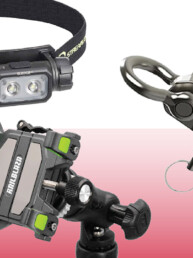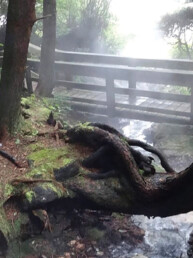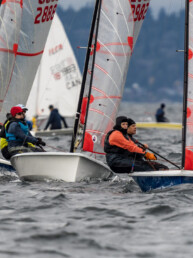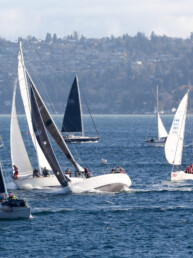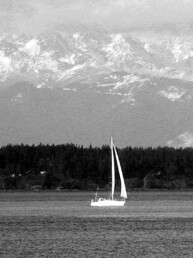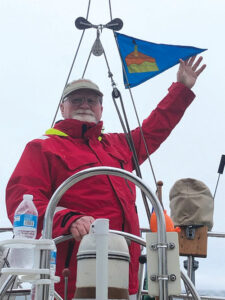
Nearly every hobby or endeavor has its unofficial fraternity or sorority membership, and sailing is no different. Woodworkers get together to share techniques and tools; Mopar car owners gather at yearly conventions; the Scots don their kilts and pipes and throw boulders or telephone poles.
In comparison, sailors have it easy. Whenever two boats are on open water, it becomes a race; and whenever they find themselves back at the dock, it turns to happy hour, possibly with folks who may have just met.
For my wife Laura and I, that camaraderie happens every time that we take Ariel out for a spin on Commencement Bay. As new owners of an older boat, we find ourselves waving to any and every boat within sight of our burgee, whether or not they belong to the same club as we do, or whether they are powered by canvas or combustion. Our universal gesture of friendship acknowledges an affinity among those who have chosen to spend time on the water, either reveling in the journey or excitedly awaiting arrival at their destination.
This fraternity is never more apparent than in the behavior and kindness of our dock mates, to the port and starboard of our marina slip. Besides lending a hand and advice in the middle of a repair, our neighbors are part of our sailing community, though each one participates in a slightly different manner, despite experiencing the water on nearly the same vessel make and model, a Cal 30 and 31.
By pure coincidence our 1973 Columbia 28 is sandwiched between these two smart-looking sloops, although I’d be hard pressed to tell which is the 30 and which is the 31. The owners of those boats, Tom and Fred, are as proud as any boat owners you could ever find, with probably over 100 years of sailing experience between them. Every time we sail with them, we learn just a little bit more, and their stories are as free flowing as their hospitality.
But, like woodworkers, car owners, and Highland games attendees, each sailor puts his own personal signature on their boat in a unique way, demonstrating the difference between the journey and the destination.

It may be that Fred sails his green-trimmed Cal, named Nemesis, more often than anyone else in Puget Sound. OK, maybe a slight exaggeration, but he logged over 90 separate sailing days last year alone, a feat which is even more impressive considering the higher than normal number of rainy days in the South Sound this past winter-spring. He calls Nemesis his “belle of the ball, the prettiest girl at the dance.” And he takes her for a spin at the drop of a hat, or the flutter of a flag.
Fred almost always sails singlehanded and I’ve never seen anyone leave the dock more efficiently than he. The diesel turns over, the shore power is disconnected, and the dock lines are released in about the same time that it takes Laura and I to unclip our mainsail cover. In the blink of an eye, Nemesis is out of her slip and gently motoring towards open water, with her skipper comfortably ensconced on a side seat of the cockpit, tiller extension in hand. For Fred, the journey is the reward. A great afternoon is tacking back and forth on the waters just outside of his marina.
Fred took Laura and I for a spin under the Narrows bridge up through Wollochet Bay in late May on a day which, like so many this past year, seemed to squeeze all four seasons between sun up and sun down. We began with barely enough breeze to overcome the tide, then witnessed a gale that found the rail nearly in the water, and finally ended up on a comfortable beam reach, sheltering under the dodger with intermittent rain showering on the bay amidst sun rays and puffy clouds.
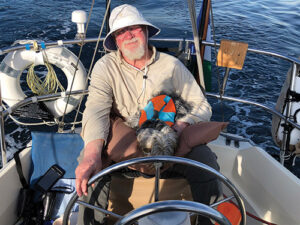
Tom was not far behind us, shepherding the fleet of perhaps 10 boats. He is truly the guardian and sentinel of the club, always concerned for the safety and enjoyment of other boaters and sailors. He is the main reason that Laura and I have begun our cruising adventures. On two separate occasions he has accompanied us through new waters, helping us navigate the turbulent caldron that is more commonly known as the Tacoma Narrows, and guiding us through long bays to unseen marinas.
Tom basks in the thought of three-day cruises at different ports of call, sharing stories and meals with fellow boaters. An avid camper in his 1978 Volkswagen Vanagon, Tom and his wife Renee make cruising feel like a night at the Ritz, with gourmet meals and comfortable cabin amenities.
As Laura and I spend more and more time on Ariel, we muse about our answer to the journey versus the destination question. And while nothing is absolute on the water or land, we refine our answer through the observations of our mentors.
It’s safe to say that no sailor defines him or herself in one way. Avid racers will muse about the thrill of a short course or the beauty and surroundings that they witness during a multi-day race, with a finish line destination at the end of their competition.
Likewise, I have learned the same about Tom. It’s not that he is only about the destination. He loves his time on the water and his enjoyment of the journey may lie in its simplicity — set a course, trim the sails, and sit back and relax amid the beauty of the vistas and company of friends and family. Once he arrives, the destination only enhances the pleasure of the journey.
On this summer’s Salish 100 small boat cruise, Laura and I had the pleasure of lending an on-shore hand to Tom and Renee, as they in turn offered support to the fleet of nearly 70 boats on their journey from Olympia to Port Townsend. After replenishing some of their supplies, we shared a bar-b-que meal with them and the skippers and first mates of the fleet, hearing mostly tales of homemade vessels and contraptions to make the journey as pleasant as the destination.
Laura and I are slowly becoming a part of the fraternity of sailors, in more than just name. We participate in club cruises, take Ariel out on evening sails to nearby docks and marinas for happy hours, and have even lent a hand to fellow sailors on a repair or a docking. We now have stories of our own to swap with other sailors and personal techniques that we have developed to make Ariel just a little bit easier to handle. But we couldn’t have done it alone.
I wonder where Laura and I would be without the help of our supportive dockmates. At one time, we felt that our struggles may have been so great as to give up on sailing entirely. But as we learn to sail Ariel, our time on the water has been improved by the support of our friends and sailing community. We are always ready and excited to receive any help or advice that they toss our way, whether it be in the form of a dock line or merely a kind word.
David Casey is a retired math teacher and semi-professional woodworker and bass player. He plans on using his retirement to build a small sailboat and a kayak, and to explore the waters of southern Puget Sound.

